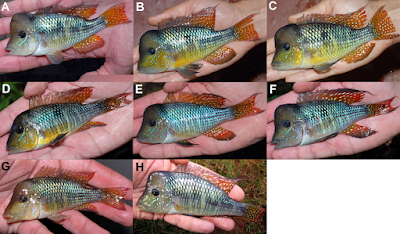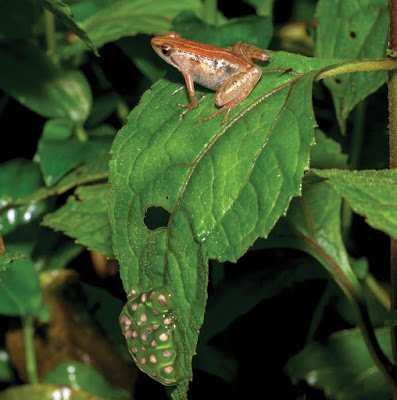[Most Recent Entries] [Calendar View]
Sunday, February 17th, 2019
| Time | Event | ||||||
| 3:37p | [Ichthyology • 2019] Gymnogeophagus jaryi • A New Species of the Neotropical Cichlid Genus Gymnogeophagus (Teleostei: Cichliformes) from the Middle Paraná Basin, Misiones, Argentina
Abstract Gymnogeophagus jaryi, new species, is described from Southern tributaries of the Middle Paraná basin in Misiones. It can be distinguished from all other members of the genus, except from G. australis and G. caaguazuensis, by the presence of a hyaline to grey anterior portion of the dorsal fin. Gymnogeophagus jaryi differs from G. caaguazuensis by a longer caudal peduncle, caudal fin not lyrate, central portion of scales on dorsal portion of trunk light iridescent blue and by white spots in soft portion of dorsal fin in adult males, and from G. australis by the light iridescent blue coloration of central portion of scales on the dorsal portion of trunk and tail, and by the lack of scales on the soft portion of the dorsal fin. Additionally, it can be diagnosed by the following unique combination of characters: 10–11 dorsal-fin branched rays, 27–30 E1 scales, absence of lips thickening, and, in males, by the possession of a hump in adults, caudal fin not lyrate, presence of large white spots forming transversal stripes distally and in anterior area of the dorsal fin’s soft portion, central area of scales on the dorsal portion of the trunk light iridescent blue, lack of scales on the base of the dorsal fin’s soft portion, absence of a conspicuous and oblique dark band from the eye to the anterior border of the head, anterior portion of dorsal fin hyaline to grey, scales of the midlateral spot each bearing a semicircular light blue blotch, head hump starting at the horizontal through the eyes, concave anterior profile in lateral view, base of unpaired fins yellow, and whitish hyaline spots on caudal fin. The new species, based on mtDNA phylogeny, is the sister species of G. caaguazuensis from the Paraguay basin and is closely related to G. australis. Gymnogeophagus jaryi, new species Diagnosis: The number of E1 scales, 27–30 (vs. 23–25), and the possession of a cephalic hump in adult males, distinguishes the new species from all species of the G. rhabdotus species group (G. rhabdotus, G. meridionalis, G. setequedas, G. che, G. terrapurpura and G. taroba). It is distinguished from all species of the G. gymnogenys group, except G. caaguazuensis and G. australis, by having the anterior portion of the dorsal fin grey to hyaline, in few specimens grey slightly reddish, with no markings (vs. red to yellow with hyaline spots or elongated transversal blotches). It differs from G. caaguazuensis by a longer caudal peduncle (18.5–22.0 vs. 13.9–17.4, % SL), caudal fin not lyrate (vs. lyrate), central portion of scales on dorsal portion of trunk light iridescent blue (vs. golden to greenish) and, in adult males, white spots in the soft portion of the dorsal fin, sometimes elongated in the distal portion forming lines (vs. with spaced small silvery to bright blue dots in G. caaguazuensis). It differs from G. australis by the light iridescent blue coloration of the central portion of scales on the dorsal portion of trunk and tail (vs. with golden central portion of scales) and by the lack of scales on dorsal-fin soft portion (vs. present). It is distinguished from G. balzanii by a lower body depth and less branched dorsal-fin rays (10–11 vs. 12–15). It can be further distinguished from G. peliochelynion, G. labiatus and G. pseudolabiatus by the absence of thickening in the lips (vs. present); from G. gymnogenys and G. mekinos by the absence of a conspicuous and oblique dark band from the anterior margin of eye to the anterior border of head; from G. gymnogenys also by presence of elongated spots distally in the soft portion of the dorsal fin (vs. large round spots); from G. mekinos also by dorsal fin coloration (vs. spiny portion without markings, soft portion with only few dots, distally immaculate). Additionally, the new species differs from G. constellatus by a semicircular light blue spot on each scale of the midlateral spot (vs. large white spot) and by spiny posterior portion with short narrow stripes or spots (vs. long wide stripes) and soft portion with dots and lines distally (vs. long wide stripes); from G. tiraparae by lacking the over-developed head hump (hump starting only at the horizontal plane through the eyes, forming a concave profile of the snout in lateral view vs. hump starting already from the upper lip, forming a convex profile at eyes height) and by a different coloration pattern of the dorsal fin (spiny posterior portion with short narrow stripes or spots and soft portion with dots and lines distally vs. dorsal fin hyaline with two horizontal series of moderately elongated light blue dots between dorsal-fin spines, and a series of light blue stripes between soft rays, and a red ground color between the two series of dots); from G. lipokarenos by presenting a red distal margin on posterior half of dorsal fin (vs. red distal margin along the entire fin), by lower peduncle length 18.5–22.0% of SL (vs. 14.1–17.9% of SL in G. lipokarenos); from G. missioneiro by having the base of unpaired fins yellow (vs. red) and by the presence of separated dots in both the spiny and soft portions of dorsal fin (vs. long wide stripes in G. missioneiro); and from G. lacustris by having lips, branchiostegal membrane and isthmus grey (vs. orange), unpaired fin-bases yellowish (vs. light olivaceous to reddish), by hyaline or white spots on caudal fin (vs. longitudinal stripes), and by absence of a dark vertical stripe through the eyes (vs. present in G. lacustris) (Figs 1–3). .... Etymology: The specific epithet is derived from the Guaraní word “jarýi”, meaning grandmother. It is dedicated to the Non-Governmental Organization of “Abuelas de Plaza de Mayo”, created in 1977 whose objective is to locate and restore to their legitimate families all the children disappeared by the last Argentine dictatorship. A noun in apposition. Distribution: Gymnogeophagus jaryi is known from several tributaries of the Southern Middle Paraná: the Cuña Pirú basin, the Garuhapé basin, and the Ñacanguazú basin in Argentina, Misiones and, based on photographs and mtDNA sequences it is also present in the Manduviyú, Pirapó and Ype Curú basins in Paraguay.  Felipe Alonso, Guillermo E. Terán, Gastón Aguilera, Oldřich Říčan, Jorge Casciotta, Wilson Sebastián Serra, Adriana Almirón, Mauricio F. Benítez, Ignacio García and Juan Marcos Mirande. 2019. Description of A New Species of the Neotropical Cichlid Genus Gymnogeophagus Miranda Ribeiro, 1918 (Teleostei: Cichliformes) from the Middle Paraná Basin, Misiones, Argentina. PLoS ONE. 14(2): e0210166. DOI: 10.1371/journal.pone.0210166 | ||||||
| 3:42p | [Herpetology • 2019] Phrynobatrachus bibita • A New Species of Puddle Frog (Anura, Phrynobatrachidae) from An Unexplored Mountain in southwestern Ethiopia
Abstract A new species of Phrynobatrachus is described from the unexplored and isolated Bibita Mountain, southwestern Ethiopia, based on morphological characters and sequences of the mitochondrial rRNA16s. The new species can be distinguished from all its congeners by a small size (SVL = 16.8 ± 0.1 mm for males, 20.3 ± 0.9 mm for females), a slender body with long legs and elongated fingers and toes, a golden coloration, a completely hidden tympanum, and a marked canthus rostralis. The phylogenetic hypothesis based on 16s sequences places the new species as sister to the species group that includes P. natalensis, although it is morphologically more similar to other dwarf Phrynobatrachus species, such as the Ethiopian P. minutus. Keywords: Bibita Mountain, Ethiopia, morphology, phylogenetic relationships, Phrynobatrachus bibita sp. n., taxonomy  Phrynobatrachus bibita Goutte, Reyes-Velasco & Boissinot, sp. n. Common name (English): Bibita Mountain dwarf puddle frog Diagnosis: Small species (SVL = 16.8 ± 0.1 mm for males, 20.3 ± 0.9 mm for females) attributed to the genus Phrynobatrachus by the presence of tarsal and outer metatarsal tubercles (Suppl. material 2: Figure S1A). Body slender, with long legs (tibia length/SVL = 0.6 in both sexes) rather long snout for the genus and very elongated fingers (hand length/SVL = 0.3 in both sexes) and toes (foot length/SVL = 0.6 in both sexes) in comparison to its congeners. Webbing absent between fingers and minimal between toes. Tympanum not visible. Canthus rostralis marked and concave from nostril to eye. Snout pointed. Nostrils not visible from above. Eyelid spine absent. Throat of adult males white with light grey freckles on the anterior third, without any spinulae. Femoral glands hardly distinguishable but present in adult males. Two ridges in the scapular region and two short, oblique ridges behind the eyes. These four ridges may be all disjointed, the two scapular ridges may be jointed to form a chevron shape, or the ridges may be jointed laterally in an hourglass shape. Etymology: The specific name refers to Bibita Mountain, the type and only known locality for the species. It is an invariable noun used in apposition. Habitat, distribution, and natural history: All individuals were collected in a single large overgrown forest pond (Figure 3A), at night. The surrounding forest consisted of large trees with overhanging epiphytes and dense undergrowth. All females and the amplected pair were found on vegetation ca. 30 cm above water (Figure 3B). A single male was found in the water, presumably while calling. All collected females were gravid, and bicolor eggs were visible through the skin. Females seemed to aggregate in specific areas of the pond, were numerous egg clutches were found on leaves overhanging the water (Figure 3B). Laying eggs on vegetation overhanging the water is unusual in Phrynobatrachus, most species laying their eggs directly in the water (Zimkus et al. 2012). We thus confirmed that these eggs belonged to Phrynobatrachus bibita sp. n. by sequencing their mitochondrial rRNA 16s. Various forms of terrestrial egg deposition have been described in the genus Phrynobatrachus (Zimkus et al. 2012): most similarly to P. bibita, P. sandersoni (Parker, 1935) lays its eggs on vegetation up to 2 m above small puddles, small streams or water-saturated soil (Amiet 1981) and P. krefftii lays its eggs above the water, on rocks or vegetation (Harper and Vonesh 2010). Phrynobatrachus guineensis Guibé & Lamotte, 1961 lays its eggs on the bark of trees above water-filled tree holes (Rödel 1998) and P. dendrobates lays its eggs in tree holes or above streams (Zimkus et al. 2012). Finally, P. phyllophilus Rödel & Ernst, 2002, P. tokba (Chabanaud, 1921), and P. villiersi Guibé, 1969 lay their eggs on the leaf litter or the forest floor (Rödel and Ernst 2002a, 2002b; Zimkus et al. 2012). Phrynobatrachus bibita sp. n. thus adds to the diversity of reproductive modes in the genus. ....
Sandra Goutte, Jacobo Reyes-Velasco and Stephane Boissinot. 2019. A New Species of Puddle Frog from An Unexplored Mountain in southwestern Ethiopia (Anura, Phrynobatrachidae, Phrynobatrachus). ZooKeys. 824: 53-70. DOI: 10.3897/zookeys.824.31570 NYUAD scientists discover tiny new frog species in Ethiopia thenational.ae/uae/nyuad-scientists-disc  |
| << Previous Day |
2019/02/17 [Calendar] |
Next Day >> |










